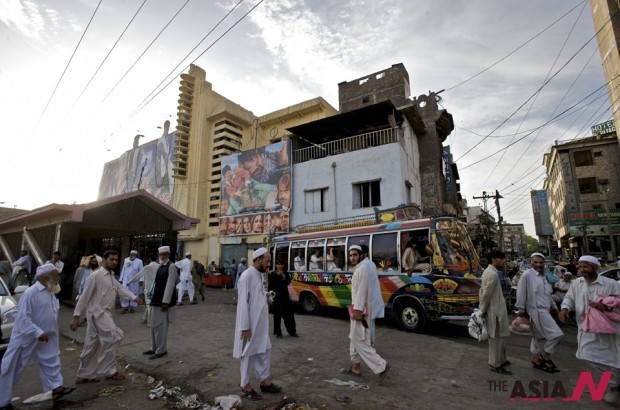파키스탄 영화 오랜 침체 딛고 ‘부활’하나

* ‘아시아엔’ 해외 필진 기고문 한글요약본과 원문을 게재합니다.
3년에 걸쳐 2백만달러의 예산을 들여 제작된 파키스탄영화 <스트라이크>는 2년 전 개봉 당시 수일 만에 90만달러의 수익을 거뒀다. <스트라이크>의 대성공은 평균 영화제작비가 2만5천달러에 불과한 파키스탄 영화시장에 파란을 일으켰다. <스트라이크>는 인도-파키스탄 분쟁을 다룬다. 영화 속 인도인들은 파키스탄 극단 이슬람 무장세력의 사주를 받고 파키스탄 습격을 계획하지만 실패한다. 때문에 인도는 <스트라이크>가 양국 갈등을 조장한다고 비평하기도 했다.
영화는 자국민의 긍정적인 변화를 이끌고, 국가 이미지를 형성하는데 중요한 역할을 한다. 그러나 정부의 지원이 없으면 영화산업은 침체하기 마련이다. 1947년 영국으로부터 독립한 ‘영국령 인도’는 힌두교를 따르는 인도와 이슬람교를 따르는 파키스탄으로 분리됐다. 파키스탄 정부는 건국 초기 영화산업을 지원했으나 70년대 들어 지원을 중단했으며, 80년대엔 영화산업에 제약을 가하기 시작했다. 이후 파키스탄영화는 급속히 내리막길을 걷게 됐다. 영화관은 80년대 1400곳에서 90년대 초엔 250곳으로 대폭 감소했다. 21세기에도 상황은 나아지지 않았다. 급기야 2009년에는 탈레반이 영화관을 습격하는 일까지 벌어졌다. 파키스탄영화 역사상 가장 암울했던 2010년엔 파키스탄영화 7편 중 6편이 처참하게 실패했다.
파키스탄영화가 퇴보하는 사이, 인도영화는 80년대 이후 파키스탄 시장을 잠식하기 시작했다. 인도-파키스탄 관계가 호전된 2006년 이후 인도영화의 파키스탄 진출은 더욱 가속화됐고, 무굴제국 황제 샤자한을 그린 <타지마할>은 파키스탄에서도 큰 인기를 끌었다. 그러나 2008년 발생한 뭄바이 테러의 배후로 파키스탄 무장세력이 지목되며 양국 영화교류가 주춤하기도 했다.

인도와 파키스탄은 인종·성 차별로 신음한다는 공통점을 갖고 있다. 2011년 9월 파키스탄 쇼아이브 만수르 감독은 ‘성차별’을 다룬 영화 <볼>을 연출해 양국에서 호평 받았다. 이는 인도관객들이 파키스탄영화에 관심 갖는 계기가 됐다. <볼>의 주연여배우 후미마 말릭도 인도를 방문해 홍보에 앞장 섰다. 그녀의 행보는 파키스탄영화와 인도영화의 경쟁을 알리는 서곡이다. 그녀는 “파키스탄영화가 새로운 시각을 바탕으로 인도영화의 그림자에서 벗어났다”고 강조한다. 번역 이진규 인턴기자
The Revival Spirit of Cinema in Pakistan
It took the Pakistani film director Bilal Lashari three years to complete his movie WAAR, with a budget of more than $2 million, but the reward was huge when it achieved an overwhelming success from its first week of show almost 2 years ago and got a net revenue of $900 thousand in just days to indicate a serious quality and technology shift in the field of film industry in Pakistan, a country that used to have an average of only $25,000 for making a single film.
The film discusses the historical issue between the two neighboring countries of India and Pakistan. A group of Indian men, in agreement with radical Islamic Pakistan militants, plan to carry out an armed attack on Pakistani territories, but the plan turns out to be a great failure. The sensitive topic of the film, which used to be a flever for similar productions by the cinema industry of the two countries, was considered by Bollywood as propaganda intended to undermine the image of India and its role in fueling the conflict between the two nations. The film was also shown commercially in Dubai, Canada and the United States.
Historical and cultural background for Pakistan
In our economically and culturally developing countries, the role of the state is vital in the guidance, education and the advancement of peoples. The seventh art in this situation is considered a cultural milestone of institutions in bringing about positive change in the behaviors and attitudes of citizens. It is also important in creating a positive mental image of those countries for nationals home and abroad. But when the state neglects its responsibilities, it paves the way for the authority of money and power to interfere. Pakistan, created through British colonization in 1947, is a clear example of that situation.
After the withdrawal of Britain from its vast colonies known as British India, the Indian peninsula was divided on the basis of sectarian religion: the Islamic Republic of Pakistan, a Muslim country, and The Republic of India, a Hindu one. Since then, the successive governments in Pakistan attempted to make an advancement through modernization, where the government, represented by the Ministry of Culture, tried to support the film industry to deal with social and political issues of the Pakistani society in depth. This stopped in the late seventies of the last century when the Ministry of Culture dropped its financial support, and even went too far in establishing technical and literary restrictions on the film industry in the eighties, and we can monitor this big decline when we know that the number of cinemas dropped from more than 1,400 movie theaters in the eighties to only 250 in the early nineties. In 2009, the film industry stopped completely when the regular attacks of the Taliban movement began on cinema theatres. The year 2010 is considered by Pakistani critics as the worst; only seven films were produced, with a fiasco fate for six of them.
The Indian cinema has invaded the markets of Pakistan in the eighties of the last century thanks to the spread of videocassette shops, which was common at that time. This invasion coincided with the decline in film production of Pakistan because of a lack of funding after the decline of the official Cinema Foundation to support this vital sector and the lack of qualified technicians, which obstructed the Pakistani sector to be competitive with their counterparts in Bollywood.
Despite the immense popularity of Indian cinema in Pakistan, Bollywood films were subject to strict control before being allowed in. The Pakistani government took a decision to ban Indian films in 1965 when war broke out between the two countries on the background of the conflict over Kashmir borders.
This prohibition has been relaxed in 2006, when relations between the two countries began to feel a gradual improvement, and the first Indian film to amuse this privilege by being shown in the Pakistan cinema theatres was Taj Mahal, based on the true story of the Mughal emperor Shah Jahan.
Pakistani films invade Indian theatres
However, the bombings in the Indian city of Mumbai in 2008, and the accusation targeting Pakistani militant groups of being behind the attack, have caused the deterioration of relations between the two neighbors again.
Duplication and racism practiced by developing communities in different ways, and various types against women and the repression these women face in poor communities are common issues between India and Pakistan.
These issues were questioned in the Pakistani director Shoaib Mansoor’s film Bol, released in September 2011. The film was warmly welcomed in the theaters of India, as it exposed the same social problems experienced by women in both countries. It knew the key gate to reach the Indian audience that remained for decades not interested in the cinema of Lahore, the capital of film industry in Pakistan. This was not the first time for Shoaib Mansoor to invade cinemas in New Delhi, as he previously presented his film For God’s Sake (Khuda Ke Liye) in 2007, which touched the issue of mixing between religion and politics and the impact of contemporary Islam seen by Muslims in general.
The actress of the film Bol, Humima Malik, who was a fashion model before becoming a cinema star, has been to India to promote her new film, a matter that expressed the boom generated by the Pakistani film industry that entered competition with Bollywood. “The Pakistani film offers new projects and visions, and has finally emerged from the mantle of Indian cinema,” she said.





